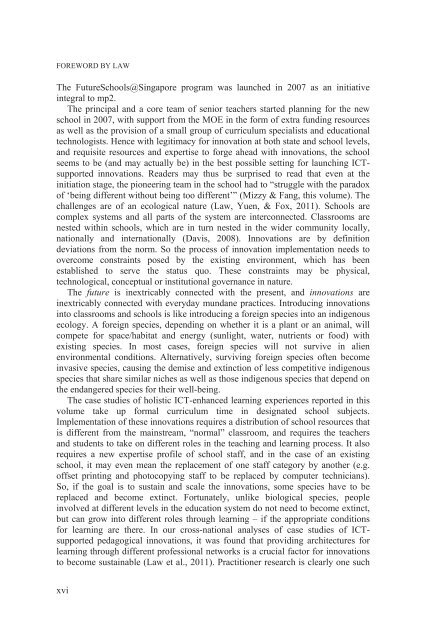1517-creating-holistic-technology-enhanced-learning-experiences
1517-creating-holistic-technology-enhanced-learning-experiences
1517-creating-holistic-technology-enhanced-learning-experiences
You also want an ePaper? Increase the reach of your titles
YUMPU automatically turns print PDFs into web optimized ePapers that Google loves.
FOREWORD BY LAW<br />
The FutureSchools@Singapore program was launched in 2007 as an initiative<br />
integral to mp2.<br />
The principal and a core team of senior teachers started planning for the new<br />
school in 2007, with support from the MOE in the form of extra funding resources<br />
as well as the provision of a small group of curriculum specialists and educational<br />
technologists. Hence with legitimacy for innovation at both state and school levels,<br />
and requisite resources and expertise to forge ahead with innovations, the school<br />
seems to be (and may actually be) in the best possible setting for launching ICTsupported<br />
innovations. Readers may thus be surprised to read that even at the<br />
initiation stage, the pioneering team in the school had to “struggle with the paradox<br />
of ‘being different without being too different’” (Mizzy & Fang, this volume). The<br />
challenges are of an ecological nature (Law, Yuen, & Fox, 2011). Schools are<br />
complex systems and all parts of the system are interconnected. Classrooms are<br />
nested within schools, which are in turn nested in the wider community locally,<br />
nationally and internationally (Davis, 2008). Innovations are by definition<br />
deviations from the norm. So the process of innovation implementation needs to<br />
overcome constraints posed by the existing environment, which has been<br />
established to serve the status quo. These constraints may be physical,<br />
technological, conceptual or institutional governance in nature.<br />
The future is inextricably connected with the present, and innovations are<br />
inextricably connected with everyday mundane practices. Introducing innovations<br />
into classrooms and schools is like introducing a foreign species into an indigenous<br />
ecology. A foreign species, depending on whether it is a plant or an animal, will<br />
compete for space/habitat and energy (sunlight, water, nutrients or food) with<br />
existing species. In most cases, foreign species will not survive in alien<br />
environmental conditions. Alternatively, surviving foreign species often become<br />
invasive species, causing the demise and extinction of less competitive indigenous<br />
species that share similar niches as well as those indigenous species that depend on<br />
the endangered species for their well-being.<br />
The case studies of <strong>holistic</strong> ICT-<strong>enhanced</strong> <strong>learning</strong> <strong>experiences</strong> reported in this<br />
volume take up formal curriculum time in designated school subjects.<br />
Implementation of these innovations requires a distribution of school resources that<br />
is different from the mainstream, “normal” classroom, and requires the teachers<br />
and students to take on different roles in the teaching and <strong>learning</strong> process. It also<br />
requires a new expertise profile of school staff, and in the case of an existing<br />
school, it may even mean the replacement of one staff category by another (e.g.<br />
offset printing and photocopying staff to be replaced by computer technicians).<br />
So, if the goal is to sustain and scale the innovations, some species have to be<br />
replaced and become extinct. Fortunately, unlike biological species, people<br />
involved at different levels in the education system do not need to become extinct,<br />
but can grow into different roles through <strong>learning</strong> – if the appropriate conditions<br />
for <strong>learning</strong> are there. In our cross-national analyses of case studies of ICTsupported<br />
pedagogical innovations, it was found that providing architectures for<br />
<strong>learning</strong> through different professional networks is a crucial factor for innovations<br />
to become sustainable (Law et al., 2011). Practitioner research is clearly one such<br />
xvi


